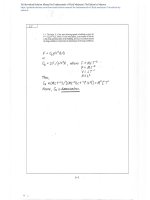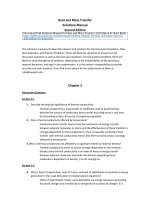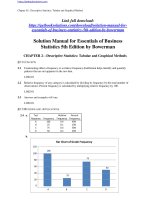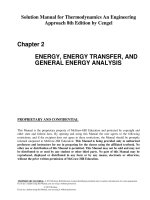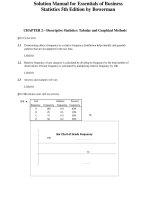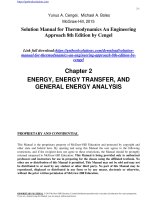Download solution manual for thermodynamics an engineering approach 8th edition by cengel
Bạn đang xem bản rút gọn của tài liệu. Xem và tải ngay bản đầy đủ của tài liệu tại đây (2.62 MB, 75 trang )
Solution Manual for Thermodynamics An Engineering
Approach 8th Edition by Cengel
Chapter 2
ENERGY, ENERGY TRANSFER, AND
GENERAL ENERGY ANALYSIS
PROPRIETARY AND CONFIDENTIAL
This Manual is the proprietary property of McGraw-Hill Education and protected by copyright and
other state and federal laws. By opening and using this Manual the user agrees to the following
restrictions, and if the recipient does not agree to these restrictions, the Manual should be promptly
returned unopened to McGraw-Hill Education: This Manual is being provided only to authorized
professors and instructors for use in preparing for the classes using the affiliated textbook. No
other use or distribution of this Manual is permitted. This Manual may not be sold and may not
be distributed to or used by any student or other third party. No part of this Manual may be
reproduced, displayed or distributed in any form or by any means, electronic or otherwise,
without the prior written permission of McGraw-Hill Education.
PROPRIETARY MATERIAL. © 2015 McGraw-Hill Education. Limited distribution permitted only to teachers and educators for course preparation.
If you are a student using this Manual, you are using it without permission.
. © 2015 McGrawIf you are a student using this Manual, you are using it without permission.
Forms of Energy
2-1C The sum of all forms of the energy a system possesses is called total energy. In the absence of magnetic, electrical
and surface tension effects, the total energy of a system consists of the kinetic, potential, and internal energies.
2-2C The internal energy of a system is made up of sensible, latent, chemical and nuclear energies. The sensible internal
energy is due to translational, rotational, and vibrational effects.
2-3C Thermal energy is the sensible and latent forms of internal energy, and it is referred to as heat in daily life.
2-4C The mechanical energy is the form of energy that can be converted to mechanical work completely and directly by
a mechanical device such as a propeller. It differs from thermal energy in that thermal energy cannot be converted to
work directly and completely. The forms of mechanical energy of a fluid stream are kinetic, potential, and flow energies.
2-5C Hydrogen is also a fuel, since it can be burned, but it is not an energy source since there are no hydrogen reserves in
the world. Hydrogen can be obtained from water by using another energy source, such as solar or nuclear energy, and then
the hydrogen obtained can be used as a fuel to power cars or generators. Therefore, it is more proper to view hydrogen is
an energy carrier than an energy source.
2-6C In electric heaters, electrical energy is converted to sensible internal energy.
2-7C The forms of energy involved are electrical energy and sensible internal energy. Electrical energy is converted
to sensible internal energy, which is transferred to the water as heat.
2-8E The total kinetic energy of an object is given is to be determined.
Analysis The total kinetic energy of the object is given by
V
KE
2
m
2
(50 ft/s )
2
1 Btu/lbm
)
(10 lbm
2
2
2
0.499 Btu
0.50
Btu
25,037 ft /s
. © 2015 McGraw Hill Education. Limited distribution permitted only to teachers and educators for course preparation.
9E The total potential energy of an object is to be determined.
Analysis Substituting the given data into the potential energy expression gives
1 Btu/lbm
PE
mgz
2.57 Btu
(200 lbm)(32.2 ft/s 2 )(10 ft)
2
2
25,037 ft /s
th
2-10
A person with his suitcase goes up to the 10 floor in an elevator. The part of the energy
of the elevator stored in the suitcase is to be determined.
. © 2015 McGrawIf you are a student using this Manual, you are using it without permission.
Assumptions 1 The vibrational effects in the elevator are negligible.
Analysis The energy stored in the suitcase is stored in the form of potential energy, which is mgz. Therefore,
Esuitcase
PE
mg z
(30 kg)(9.81 m/s
2
1 kJ/kg
)(35 m)
10.3 kJ
2 2
1000 m /s
th
Therefore, the suitcase on 10 floor has 10.3 kJ more energy compared to an identical suitcase on the lobby level.
Discussion Noting that 1 kWh = 3600 kJ, the energy transferred to the suitcase is 10.3/3600 = 0.0029 kWh, which is
very small.
2-11
A hydraulic turbine-generator is to generate electricity from the water of a large reservoir.
The power generation potential is to be determined.
Assumptions 1 The elevation of the reservoir remains constant. 2 The
mechanical energy of water at the turbine exit is negligible.
Analysis The total mechanical energy water in a reservoir possesses is
equivalent to the potential energy of water at the free surface, and it
can be converted to work entirely. Therefore, the power potential of
water is its potential energy, which is
gz per unit mass,
and mgz for a given mass flow rate.
e mech
pe
gz (9.81 m/s
1.177 kJ/kg
1 kJ/kg
2 )(120 m)
2
2
1000 m /s
Then the power generation potential becomes
Wmax
Emech
memech
(2400 kg/s)(1.177 kJ /kg
)
1 kW
2825 kW
1 kJ/s
Therefore, the reservoir has the potential to generate 2825 kW of power.
Discussion This problem can also be solved by considering a point at the turbine inlet, and using flow energy instead of
potential energy. It would give the same result since the flow energy at the turbine inlet is equal to the potential energy at
the free surface of the
reservoir.
PROPRIETARY MATERI AL
Hill Education. Limited distribution permitted only to teachers and educators for course
preparation.
. © 2015 McGrawIf you are a student using this Manual, you are using it without permission.
2-4
212 Wind is blowing steadily at a certain velocity. The mechanical energy of air per unit mass and the power
generation potential are to be determined.
Assumptions The wind is blowing steadily at a constant
uniform
velocity.
Wind
turbine
Wind
3
Properties The density of air is given to be
10 m/s
60 m
= 1.25 kg/m .
Analysis Kinetic energy is the only form of mechanical energy
the wind possesses, and it can be converted to work entirely.
Therefore, the power potential of the wind is its kinetic energy,
2
which is V /2 per unit mass, and mV
rate:
e
V
(10 m/s)
2 2
1000 m /s
2
2
2
W max
Emech
mech
ke
0.050 kJ/kg
2
(60 m)2
3
V
VA
/ 2 for a given mass flow
1 kJ/kg
D2
m
2
(1.25
4
memech
kg/m
(35,340 kg/s)(0.050 kJ/kg)
)(10 m/s)
4
35
,340 kg/s
1770 kW
Therefore, 1770 kW of actual power can be generated by this wind turbine at the stated conditions.
Discussion The power generation of a wind turbine is proportional to the cube of the wind velocity, and thus the
power generation will change strongly with the wind conditions.
2-13 A water jet strikes the buckets located on the perimeter of a wheel at a specified velocity and flow rate. The
power generation potential of this system is to be determined.
Assumptions Water jet flows steadily at the specified speed and flow
rate.
Analysis Kinetic energy is the only form of harvestable mechanical energy
the water jet possesses, and it can be converted to work entirely. Therefore,
2
the power potential of the water jet is its kinetic energy, which is V /2 per
2
unit mass, and mV / 2 for a given mass flow rate:
2
2
V
e
(60 m/s)
Shaft
1 kJ/kg
ke
1.8 kJ/kg
2 2 mech
2
Nozzle
2
1000 m /s
Vj
W
max
E
me
mech
mech
1 kW
(120 kg/s)(1.8 kJ/kg)
216 kW
PROPRIETARY MATERIAL . © 2015 McGrawIf you are a student using this Manual, you are using it without permission.
2-5
21 kJ/s
Therefore, 216 kW of power can be generated by this water jet at the stated conditions.
Discussion An actual hydroelectric turbine (such as the Pelton wheel) can convert over 90% of this potential to
actual electric power.
Hill Education. Limited distribution permitted only to teachers and educators for course preparation.
14 Two sites with specified wind data are being considered for wind power generation. The site better suited for
wind power generation is to be determined.
Assumptions 1The wind is blowing steadily at specified velocity during specified times. 2 The wind power
generation is negligible during other times.
3
Properties We take the density of air to be
affect the final answer).
= 1.25 kg/m (it
does not
Wind
Wind
Analysis Kinetic energy is the only form of mechanical energy
the wind possesses, and it can be converted to work entirely.
Therefore, the power potential of the wind is
energy,
2
turbine
V, m/s
its kinetic
2
which is V /2 per unit mass, and mV / 2 for a given mass flow rate.
2
Considering a unit flow area (A = 1 m ), the maximum wind power and
power generation becomes
emech, 1
ke1
V1
2
(7 m/s)
2
2
2
2
emech, 2
ke2
2
2
3
2
1 kJ/kg
2
1000 m /s
0.0245 kJ/kg
2
2
V
2
2
1 kJ/kg
(10 m/s)
0.050 kJ/kg
2
1000 m /s
Wmax, 1
Emech, 1
m1emech, 1
V1 Ake1
(1.25 kg/m )(7 m/s)(1 m )(0.0245 kJ/kg)
Wmax, 2
Emech, 2
m2 emech, 2
V2 Ake2
(1.25 kg/m )(10 m/s)(1 m )(0.050 kJ/kg)
3
0.2144 kW
2
0.625 kW
since 1 kW = 1 kJ/s. Then the maximum electric power generations per year become
2
Emax, 1
Wmax, 1 t1
(0.2144 kW)(3000 h/yr)
643 kWh/yr (per m flow area)
2
Emax, 2 Wmax, 2 t2
(0.625 kW)(1500 h/yr)
Therefore, second site is a better one for wind generation.
PROPRIETARY MATERIAL . © 2015 McGrawIf you are a student using this Manual, you are using it without permission.
938 kWh/yr (per m flow area)
2-6
2Discussion Note the power generation of a wind turbine is proportional to the cube of the wind velocity, and thus
the average wind velocity is the primary consideration in wind power generation decisions.
Hill Education. Limited distribution permitted only to teachers and educators for course preparation.
15 A river flowing steadily at a specified flow rate is considered for hydroelectric power generation by collecting the
water in a dam. For a specified water height, the power generation potential is to be determined.
Assumptions 1 The elevation given is the elevation of the free surface of the river. 2 The mechanical energy of water at
the turbine exit is negligible.
3
Properties We take the density of water to be
Analysis
possesses is
= 1000 kg/m .
River
The total mechanical energy the water in a dam
equivalent to the potential energy of water at the free surface of the
dam (relative to free surface of discharge water), and it can be
converted to work entirely. Therefore, the power potential of water is
its potential energy, which is gz per unit mass, and mgz for a given
mass flow rate.
2
e
1 kJ/kg
gz (9.81 m/s
0.7848 kJ/kg
mech
pe
)(80 m)
2
2
1000 m /s
The mass flow rate is
3
m
3
V
(1000 kg/m )(175
m /s) 175,000 kg/s
Then the power generation potential becomes
W
1 MW
max
Emech
memech
137 MW
(175,000 kg/s)(0.7 848 kJ /kg)
1000 kJ/s
Therefore, 137 MW of power can be generated from this river if its power potential can be recovered completely.
Discussion Note that the power output of an actual turbine will be less than 137 MW because of losses and inefficiencies.
2-16 A river is flowing at a specified velocity, flow rate, and elevation. The total mechanical energy of the river
water per unit mass, and the power generation potential of the entire river are to be determined.
Assumptions 1 The elevation given is the elevation of the free surface of the river. 2 The velocity given is the
average velocity. 3 The mechanical energy of water at the turbine exit is negligible.
PROPRIETARY MATERIAL . © 2015 McGrawIf you are a student using this Manual, you are using it without permission.
2-7
2Properties
We take the density of water to
3
be = 1000 kg/m .
River
3 m/s
Analysis Noting that the sum of the flow energy
and the potential energy is constant for a given
fluid body, we can take the elevation of the entire
river water to be the elevation of the free surface,
and ignore the flow energy. Then the total
mechanical energy of the river water per unit mass
becomes
2
V
e
mech
pe
ke
2
gh
(9.81 m/s )(90 m)
2
2
2
2 1000 m /s
The power generation potential of the river water is obtained by multiplying the total mechanical energy by the mass
flow rate,
3
3
m
m /s)
Wmax
V
(1000 kg/m )(500
500,000 kg/s
Emech
memech
(500,000 kg/s)(0.887 kJ/kg)
444,000 kW
444 MW
Therefore, 444 MW of power can be generated from this river as it discharges into the lake if its power potential can
be recovered completely.
Discussion Note that the kinetic energy of water is negligible compared to the potential energy, and it can be ignored in
the analysis. Also, the power output of an actual turbine will be less than 444 MW because of losses and inefficiencies.
Hill Education. Limited distribution permitted only to teachers and educators for course preparation.
PROPRIETARY MATERIAL . © 2015 McGrawIf you are a student using this Manual, you are using it without permission.
2-8
Energy Transfer by Heat and Work
2-17C The form of energy that crosses the boundary of a closed system because of a temperature difference is heat; all
other forms are work.
2-18C (a) The car's radiator transfers heat from the hot engine cooling fluid to the cooler air. No work interaction occurs in
the radiator.
(b) The hot engine transfers heat to cooling fluid and ambient air while delivering work to the transmission.
(c) The warm tires transfer heat to the cooler air and to some degree to the cooler road while no work is produced.
No work is produced since there is no motion of the forces acting at the interface between the tire and road.
(d) There is minor amount of heat transfer between the tires and road. Presuming that the tires are hotter than the
road, the heat transfer is from the tires to the road. There is no work exchange associated with the road since it cannot move.
(e) Heat is being added to the atmospheric air by the hotter components of the car. Work is being done on the air as
it passes over and through the car.
2-19C (a) From the perspective of the contents, heat must be removed in order to reduce and maintain the content's
temperature. Heat is also being added to the contents from the room air since the room air is hotter than the contents.
(b) Considering the system formed by the refrigerator box when the doors are closed, there are three interactions,
electrical work and two heat transfers. There is a transfer of heat from the room air to the refrigerator through its walls. There is
also a transfer of heat from the hot portions of the refrigerator (i.e., back of the compressor where condenser is placed) system
to the room air. Finally, electrical work is being added to the refrigerator through the refrigeration system.
(c) Heat is transferred through the walls of the room from the warm room air to the cold winter air. Electrical
work
is being done on the room through the electrical wiring leading into the room.
2-20C It is a work interaction.
2-21C It is a work interaction since the electrons are crossing the system boundary, thus doing electrical work.
2-22C It is a heat interaction since it is due to the temperature difference between the sun and the room.
2-23C This is neither a heat nor a work interaction since no energy is crossing the system boundary. This is simply
the conversion of one form of internal energy (chemical energy) to another form (sensible energy).
Hill Education. Limited distribution permitted only to teachers and educators for course preparation.
24 The power produced by an electrical motor is to be expressed in different units.
Analysis Using appropriate conversion factors, we obtain
(a)
W
(5 W
)
1 J/s
1N
m
5N
m/s
PROPRIETARY MATERIAL . © 2015 McGrawIf you are a student using this Manual, you are using it without permission.
2-9
1W
1 J/s
1J
1N
m
m/s2
1 kg
2
3
(b)
W
5 kg m /s
(5 W)
1W
1N
1J
2-25E The power produced by a model aircraft engine is to be expressed in different units.
Analysis Using appropriate conversion factors, we obtain
1 Btu/s
(a)
W
778.169 lbf ft/s
7.38 lbf
(10 W)
1055.056 W
(b)
W
(10
W)
1 hp
0.0134
ft/s
1 Btu/s
hp
745.7 W
Mechanical Forms of Work
2-26C The work done is the same, but the power is different.
2-27E A construction crane lifting a concrete beam is considered. The amount of work is to be determined considering
(a) the beam and (b) the crane as the system.
Analysis (a) The work is done on the beam and it is determined from
1 lbf
W
mg z
2
2 (24 ft
(3 2000 lbm)(32.174 ft/s )
)
32.174 lbm ft/s
144,000lbf
ft
24 ft
1 Btu
185 Btu
(144,000 lbf ft)
778.169 lbf ft
(b) Since the crane must produce the same amount of work as is required to lift the beam, the
work done by the crane is
W
144,000lbf
ft
185 Btu
PROPRIETARY MATERIAL . © 2015 McGrawIf you are a student using this Manual, you are using it without permission.
2-28E A man is pushing a cart with its contents up a ramp that is inclined at an angle of 10° from the horizontal. The work
needed to move along this ramp is to be determined considering (a) the man and (b) the cart and its contents as the system.
Analysis (a) Considering the man as the system, letting l be the displacement along the ramp, and letting
inclination angle of the ramp,
be the
Hill Education. Limited distribution permitted only to teachers and educators for course preparation.
2-10
W
Fl sin
(100 180 lbf )(100 ft)sin(10)
4862 lbf
ft
1 Btu
(4862 lbf
6.248 Btu
ft)
778.169 lbf ft
This is work that the man must do to raise the weight of the cart and contents, plus his own weight, a distance of
lsin . (b) Applying the same logic to the cart and its contents gives
W
Fl sin
1736 lbf
(100 lbf )(100 ft)sin(10)
ft
1 Btu
(1736 lbf
2.231Btu
ft)
778.169 lbf ft
2-29E The work required to compress a spring is to be determined.
Analysis Since there is no preload, F = kx. Substituting this into the work expression gives
2
2
kxdx
2W
2
k
1
2
2
k xdx
(x2
1
F
Fds
x1 )
x
1
200 lbf/in
2
2
1 ft
(1 in)
2
0
8.33 lb
12 in
1 Btu
0.0107Btu
(8.33 lbf ft)
778.169 lbf ft
2-30 A car is accelerated from 10 to 60 km/h on an uphill road. The work needed to achieve this is to be determined.
Analysis The total work required is the sum of the changes in potential and kinetic energies,
1
mV2
Wa
1000 kg
m
2/s 2
2
2
1
2
60,000 m
10
,000 m
2
V1 (1300 kg)
175.5 kJ
1 kJ
3600 s
3600 s
2
2
and
W
mg
z
z
1 kJ
)
510.0 kJ
2
1
(1300 kg)(9.81 m/s
2
)(40 m
g
2
2
1000 kg
m /s
Thus,
Wtotal
Wa Wg
175.5
510.0
686 kJ
Hill Education. Limited distribution permitted only to teachers and educators for course preparation.
2-11
PROPRIETARY MATERIAL . © 2015 McGrawIf you are a student using this Manual, you are using it without permission.
31E The engine of a car develops 450 hp at 3000 rpm. The torque transmitted through the shaft is to be determined.
Analysis The torque is determined from
W
450 hp
550 lbf
ft/s
T
788 lbf
sh
2 n 2
3000/60 /s
ft
1 hp
2-32E The work required to expand a soap bubble is to be determined.
Analysis Noting that there are two gas-liquid interfaces in a soap bubble, the surface tension work is determined from
2
W
2
2
s dA
( A1
A2 )
2
2(0.005 lbf/ft ) (3 / 12 ft )
(0.5 / 12 ft )
1
0.001909 lbf
Btu
ft
(0.001909 lbf
1
ft)
6
12.45 10
Btu
778.2 lbf
ft
2-33 A linear spring is elongated by 20 cm from its rest position. The work done is to be determined. Analysis
The spring work can be determined from
1
Wspring
2
2 k(x2
2
x1 )
1
2 (70 kN/m)(0.2
2
0) m
2
1.4 kN
m
1.4 kJ
PROPRIETARY MATERIAL . © 2015 McGrawIf you are a student using this Manual, you are using it without permission.
2-34 A ski lift is operating steadily at 10 km/h. The power required to operate and also to accelerate this ski lift from rest to
the operating speed are to be determined.
Assumptions 1 Air drag and friction are negligible. 2 The average mass of each loaded chair is 250 kg. 3 The mass of chairs
is small relative to the mass of people, and thus the contribution of returning empty chairs to the motion is disregarded (this
provides a safety factor).
Analysis The lift is 1000 m long and the chairs are spaced 20 m apart. Thus at any given time there are 1000/20 = 50 chairs
being lifted. Considering that the mass of each chair is 250 kg, the load of the lift at any given time is
Load = (50 chairs)(250 kg/chair) = 12,500 kg
Neglecting the work done on the system by the returning empty chairs, the work needed to raise this mass by 200 m
is
Hill Education. Limited distribution permitted only to teachers and educators for course preparation.
2-12
1 kJ
Wg
2
mg z
1000 kg
t
z1
2 2
(12,500 kg)(9.81 m/s2 )(200 m)
m /s
24,525 kJ
At 10 km/h, it will take
distance
1 km
0.1 h
360 s
velocity 10 km / h
to do this work. Thus the power needed is
W
g
24,525 kJ
Wg
t
68.1kW
360 s
The velocity of the lift during steady operation, and the acceleration during start up are
1 m/s
V
(10 km/h)
3.6 km/h
0.556 m/s
t
2.778 m/s
a
V
2.778 m/s - 0
2
5s
During acceleration, the power needed is
1
2
2
m(V2 V1 ) /
Wa
2
t
1
1 kJ/kg
2
(12,500 kg) (2.778 m/s
2
1000
)
2
0
2
/(5 s)
9.6 kW
m /s
Assuming the power applied is constant, the acceleration will also be constant and the vertical distance traveled
during acceleration will be
1 2
2 at
h
1 2 200 m
1
sin
2 at 1000 m
2
2
2 (0.556 m/s )(5 s
) (0.2)
1.39 m
and
mg z2
Wg
z1
/ t
(12,500 kg)(9.81 m/s
2
)(1.39 m)
1 kJ/kg
1000 kg
2
2
/(5 s)
34.1 kW
m /s
Thus,
W
total
Wa Wg
9.6
34.1
43.7 kW
PROPRIETARY MATERIAL . © 2015 McGrawIf you are a student using this Manual, you are using it without permission.
35 The engine of a car develops 75 kW of power. The acceleration time of this car from rest to 100 km/h on a level road
is to be determined.
Hill Education. Limited distribution permitted only to teachers and educators for course preparation.
2-13
Analysis The work needed to accelerate a body is the change in its kinetic energy,
100,000 m
1
2
Wa
1
2
V1
m V2
578.7 kJ
0
(1500 kg)
2
2
Thus the time required is
Wa
1 kJ
2
3600 s
2
1000 kg
2
m /s
578.7 kJ
t
7.72 s
Wa 75 kJ/s
This answer is not realistic because part of the power will be used against the
air drag, friction, and rolling resistance.
2-36 A car is to climb a hill in 12 s. The power needed is to be determined for three different cases.
Assumptions Air drag, friction, and rolling resistance are negligible.
Analysis The total power required for each case is the sum of the rates of
changes in potential and kinetic energies. That is,
Wtotal
Wa Wg
(a) Wa 0 since the velocity is constant. Also, the vertical rise is h = (100
m)(sin 30 ) = 50 m. Thus,
1 kJ
W
mg
(z
2
2
and
Wtotal Wa
Wg
0
z)/ t
1
2
/(12 s)
47.0
1000
47.0 kW
47.0
(1150 kg)(9.81 m/s
kg
2 )(50 m)
kW
g
m /s
(b) The power needed to accelerate is
1
m(V2
Wa
2
and
W
W
total
a
2
(1150 kg)
V1 ) /2 t
2
Wg
47.0
1000 kg
43.1
30 m/s
2
0
2
2
1
/(12 s)
43.1
m /s
90.1 kW
(c) The power needed to decelerate is
1
1
W
a
and
Wtotal Wa
m(V2
2
2
Wg
57.5
V1 ) /2 t
47.1
10.5 kW
1 kJ
(1150 kg)
2
5 m/s
35 m/s
2
(breaking power
)
2 2
2
1000 kg
/(12 s)
57.5 kW
m
/s
Hill Education. Limited distribution permitted only to teachers and educators for course preparation.
2-14
PROPRIETARY MATERIAL . © 2015 McGrawIf you are a student using this Manual, you are using it without permission.
The First Law of Thermodynamics
2-37C Energy can be transferred to or from a control volume as heat, various forms of work, and by mass transport.
2-38C Warmer. Because energy is added to the room air in the form of electrical work.
2-39 Water is heated in a pan on top of a range while being stirred. The energy of the water at the end of the process is to be
determined.
Assumptions The pan is stationary and thus the changes in kinetic and potential energies are negligible.
Analysis We take the water in the pan as our system. This is a closed system since no mass enters or leaves. Applying
the energy balance on this system gives
E E
in
E
out
system
Net energy transfer
Changein internal,
kinetic, by heat, work, and mass
potential,
etc. energies
Qin Wsh,in
30 kJ
Qout
0.5 kJ
U
5 kJ
U 2 U1
U 2 10 kJ
35.5 kJ
U2
Therefore, the final internal energy of the system is 35.5 kJ.
2-40E Water is heated in a cylinder on top of a range. The change in the energy of the water during this process is to be
determined.
Assumptions The pan is stationary and thus the changes in kinetic and potential energies are negligible.
Analysis We take the water in the cylinder as the system. This is a closed system since no mass enters or leaves.
Applying the energy balance on this system givesE
E
Esystem
in out
Net energy transfer by
Changein internal,
kinetic,potential, etc. energies heat, work, and mass
Q W Q
in
65 Btu
out
U
out
5 Btu
8
Btu U
U 2 U1
U
U 2 U1
52 Btu
Therefore, the energy content of the system increases by 52 Btu during this process.
Hill Education. Limited distribution permitted only to teachers and educators for course preparation.
2-15
PROPRIETARY MATERIAL . © 2015 McGrawIf you are a student using this Manual, you are using it without permission.
41E The heat loss from a house is to be made up by heat gain from people, lights, appliances, and resistance heaters. For
a specified rate of heat loss, the required rated power of resistance heaters is to be determined.
Assumptions 1 The house is well-sealed, so no air enters or heaves the house. 2 All the lights and appliances are kept on. 3
The house temperature remains constant. Analysis Taking the house as the system, the energy balance can be written as
E
dEsystem / dt 0 (steady
E
in
Rate of net energy transfer Rate of changein internal, kinetic,
where Eout
Qout
E
E
0
)
Ein
Eout
out
HOUSE
by heat, work, and mass potential,etc. energies
60,000 Btu/h and
E
E
E 6000 Btu/h E in
people lights appliance heater
- Lights Q
- People out
heater
Energy
- Appliance
- Heaters
Substituting, the required power rating of the heaters becomes
1 kW
Eheater
60,000
15.8 kW
54,000 Btu/h
6000
3412 Btu/h
Discussion When the energy gain of the house equals the energy loss, the temperature of the house remains constant. But
when the energy supplied drops below the heat loss, the house temperature starts dropping.
2-42E A water pump increases water pressure. The power input is to be determined.
Analysis The power input is determined from
P1 )
W V (P2
70 psia
1 Btu
3
(0.8 ft
Water
/s)(70
15)psia
1 hp
3
5.404 psia
ft
0.7068 Btu/s
15 psia
11.5 hp
The water temperature at the inlet does not have any significant effect on the required power.
PROPRIETARY MATERIAL . © 2015 McGrawIf you are a student using this Manual, you are using it without permission.
Hill Education. Limited distribution permitted only to teachers and educators for course preparation.
2-16
243 A water pump is claimed to raise water to a specified elevation at a specified rate while consuming electric power at a
specified rate. The validity of this claim is to be investigated.
Assumptions 1 The water pump operates steadily. 2 Both the lake and the pool are open to the atmosphere, and the flow
velocities in them are negligible.
3
Properties We take the density of water to be
= 1000 kg/m = 1
kg/L.
Analysis For a control volume that encloses the pump-motor unit, the
energy balance can be written as
E E
in out
dEsystem / dt
Rate of net energy transfer
0
0
(steady)
Rate of changein internal, kinetic,
by heat, work, and mass
Ein
potential, etc. energies
Eout
Win mpe1 mpe 2
Win m pe mg(z2 z1 )
since the changes in kinetic and flow energies of water are negligible. Also,
m
V (1 kg/L)(50 L/s) 50 kg/s
Substituting, the minimum power input required is determined to be
Win
2
mg (z2
z1)
(50 kg/s)(9.81 m/s )(3 0 m
)
1 kJ/kg
14.7 kJ /s
14.7 kW
22
1000 m /s
which is much greater than 2 kW. Therefore, the claim is false.
Discussion The conservation of energy principle requires the energy to be conserved as it is converted from one form to
another, and it does not allow any energy to be created or destroyed during a process. In reality, the power required will be
considerably higher than 14.7 kW because of the losses associated with the conversion of electrical-to-mechanical shaft and
mechanical shaft-to-potential energy of water.
2-44 A classroom is to be air-conditioned using window air-conditioning units. The cooling load is due to people, lights,
and heat transfer through the walls and the windows. The number of 5-kW window air conditioning units required is to
be determined.
Assumptions There are no heat dissipating equipment (such as computers, TVs, or ranges) in the
room. Analysis The total cooling load of the room is determined from
Q
Q
cooling
Q
lights
where
Q
people
heat gain
Room
Hill Education. Limited distribution permitted only to teachers
40 people
and educators for course preparation.
10 bulbs
2-17
2Qlights
Qpeople
Q
1 4
4.17
10 100 W
40
1 kW
360 kJ / h
· heat gain
4 kW
15,000 kJ / h
4.17 kW
15,000 kJ/h QcoolSubstituting,
Qcooling
9.17 kW
Thus the number of air-conditioning units required is
9.17 kW
5 kW/unit
1.83
2 units
PROPRIETARY MATERIAL . © 2015 McGrawIf you are a student using this Manual, you are using it without permission.
45 The classrooms and faculty offices of a university campus are not occupied an average of 4 hours a day, but the lights
are kept on. The amounts of electricity and money the campus will save per year if the lights are turned off during
unoccupied periods are to be determined.
Analysis The total electric power consumed by the lights in the classrooms and faculty offices is
Elighting,classroom
Elighting,offices
E
(Power consumed per lamp) (No. of lamps) = (200 12 110 W) = 264,000
(Power consumed per lamp) (No. of lamps) = (400 6 110 W) = 264,000
E
lighting,total
E
lighting,classroom
264
264
264 kW
264 kW
528 kW
lighting,offices
Noting that the campus is open 240 days a year, the total number of unoccupied work hours per year
is Unoccupied hours = (4 hours/day)(240 days/year) = 960 h/yr
Then the amount of electrical energy consumed per year during unoccupied work period and its cost are
Energy savings
Cost savings
(Elighting,total )(Unoccupied hours)
(Energy savings)(Unit cost of energy)
(528 kW)(960 h/yr)
506,880 kWh
(506,880 kWh/yr)($0.11/kWh)
$55,757/yr
Discussion Note that simple conservation measures can result in significant energy and cost savings.
2-46 An industrial facility is to replace its 40-W standard fluorescent lamps by their 35-W high efficiency counterparts.
The amount of energy and money that will be saved a year as well as the simple payback period are to be determined.
Analysis The reduction in the total electric power consumed by the lighting as a result of switching to the high efficiency
fluorescent is
Wattage reduction = (Wattage reduction per lamp)(Number of lamps)
= (40 - 34 W/lamp)(700 lamps)
= 4200 W
Then using the relations given earlier, the energy and cost savings associated with the
replacement of the high efficiency fluorescent lamps are determined to be
Energy Savings = (Total wattage reduction)(Ballast factor)(Operating hours)
= (4.2 kW)(1.1)(2800 h/year)
Hill Education. Limited distribution permitted only to teachers and educators for course preparation.
2-18
2= 12,936 kWh/year
Cost Savings = (Energy savings)(Unit electricity cost)
= (12,936 kWh/year)($0.105/kWh)
= $1358/year
The implementation cost of this measure is simply the extra cost of the energy efficient fluorescent bulbs
to standard ones, and is determined to be
relative
Implementation Cost = (Cost difference of lamps)(Number of lamps)
= [($2.26-$1.77)/lamp](700 lamps)
= $343
This gives a simple payback period of
Simple payback period = Implementation cost
$343 0.25 year (3.0 months)
Annual cost savings
$1358 / year
Discussion Note that if all the lamps were burned out today and are replaced by high-efficiency lamps instead of the
conventional ones, the savings from electricity cost would pay for the cost differential in about 4 months. The electricity
saved will also help the environment by reducing the amount of CO 2, CO, NOx, etc. associated with the generation of
electricity in a power plant.
PROPRIETARY MATERIAL . © 2015 McGrawIf you are a student using this Manual, you are using it without permission.
47 A room contains a light bulb, a TV set, a refrigerator, and an iron. The rate of increase of the energy content of
the room when all of these electric devices are on is to be determined.
Assumptions 1 The room is well sealed, and heat loss from the room is negligible. 2 All the appliances are kept
on. Analysis Taking the room as the system, the rate form of the energy balance can be written as
Ein Eout
dEsystem / dt
Rate of net energy transfer
by heat, work, and mass
Rate of changein internal, kinetic,
potential, etc. energies
since no energy is leaving the room in any form, and thus Eout
E in
Elights
40
ETV
Erefrig
110
dEroom / dt
Ein
0 . Also,
ROOM
Eiron
300
1200 W
Electricity
1650 W
- Lights
- TV
- Refrig
- Iron
Substituting, the rate of increase in the energy content of the room becomes
dEroom / dt Ein 1650 W
Discussion Note that some appliances such as refrigerators and irons operate intermittently, switching on and off
as controlled by a thermostat. Therefore, the rate of energy transfer to the room, in general, will be less.
2-48E A fan accelerates air to a specified velocity in a square duct. The minimum electric power that must be supplied to
the fan motor is to be determined.
Assumptions 1 The fan operates steadily. 2 There are no conversion losses.
Hill Education. Limited distribution permitted only to teachers and educators for course preparation.
2-19
2Properties The density of air is given to be
3
= 0.075 lbm/ft .
Analysis A fan motor converts electrical energy to mechanical shaft energy, and the fan transmits the mechanical energy
of the shaft (shaft power) to mechanical energy of air (kinetic energy). For a control volume that encloses the fan-motor
unit, the energy balance can be written as
Ein
Eout by heat, work, and mass potential, etc. energies
Rate of changein internal, kinetic,
Rate of net energy transfer
dEsystem / dt
0 (steady
)
0
Vout2
W
elect, in
m ke
air
out
m
2 where
air
2m
3
VA
(0.075 lbm/ft )(3 3 ft )(22 ft/s) 14.85 lbm/s
Substituting, the
air
minimum power input required is determined to be
W in
m
Vout2
air
2
(14.85 lbm/s)
2
(22 ft/s) 2
25,037 ft /s
1 Btu/lbm2
0.1435 Btu/s
2
151 W
since 1 Btu = 1.055 kJ and 1 kJ/s
= 1000 W.
Discussion The conservation of energy principle requires the energy to be conserved as it is converted from one form to
another, and it does not allow any energy to be created or destroyed during a process. In reality, the power required will
be considerably higher because of the losses associated with the conversion of electrical-to-mechanical shaft and
mechanical shaft-to-kinetic energy of air.
PROPRIETARY MATERIAL . © 2015 McGrawIf you are a student using this Manual, you are using it without permission.
49 The fan of a central heating system circulates air through the ducts. For a specified pressure rise, the highest possible
average flow velocity is to be determined.
Assumptions 1 The fan operates steadily. 2 The changes in kinetic and potential energies across the fan are
negligible. Analysis For a control volume that encloses the fan unit, the energy balance can be written as
Ein
dEsystem / dt 0 (steady)
Eout
Rate of net energy transfer
m(Pv)1
m(Pv) 2
Ein
Eout
Rate of changein internal, kinetic,
by heat, work, and mass
Win
0
Win
potential, etc. energies
m(P2
P1 )v
V
P
since m V/v and the changes in kinetic and potential energies of gasoline are
negligible, Solving for volume flow rate and substituting, the maximum flow
rate and velocity are determined to be
P = 50 Pa
1
Air
V m/s
2
D = 30 cm
60 W
Hill Education. Limited distribution permitted only to teachers and educators for course preparation.
2-20
2-
W
in
60 J/s 1 Pa
m3
V
P
V
50
V max
A
max
Pa
3
1.2 m /s
max
1J
3
V max
17.0 m/s
1.2 m /s
2
(0.30 m)2 /4
D /4
c
Discussion The conservation of energy principle requires the energy to be conserved as it is converted from one form to
another, and it does not allow any energy to be created or destroyed during a process. In reality, the velocity will be less
because of the losses associated with the conversion of electrical-to-mechanical shaft and mechanical shaft-to-flow energy.
2-50
A gasoline pump raises the pressure to a specified value while consuming electric power at a specified rate.
The maximum volume flow rate of gasoline is to be determined.
Assumptions 1 The gasoline pump operates steadily. 2 The changes in kinetic and potential energies across the pump
are negligible.
Analysis For a control volume that encloses the pump-motor unit, the energy balance can be writt en as
Ein
Eout
dEsystem / dt 0 (steady)
Rate of net energy transferby heat, work, and mass
W
in
m(Pv )
1
0
Ein
Eout
3.8 kW
Rate of changein internal, kinetic, potential,etc. energies
m(P v )
W
2
m(P
P )v V P
in
2
PUMP
1
Motor
since m V/v and the changes in kinetic and potential energies
Pump
inlet
of
gasoline are negligible, Solving for volume flow rate and
be
substituting, the maximum flow rate is determined to
3
W
V
3.8 kJ/s 1 kPa
m
in
3
0.543 m /s max
P 7 kPa
1 kJ
Discussion The conservation of energy principle requires the energy to be conserved as it is converted from one form to
another, and it does not allow any energy to be created or destroyed during a process. In reality, the volume flow rate will
be less because of the losses associated with the conversion of electrical-to-mechanical shaft and mechanical shaft-to-flow
energy.
PROPRIETARY MATERIAL . © 2015 McGrawIf you are a student using this Manual, you are using it without permission.
Hill Education. Limited distribution permitted only to teachers and educators for course preparation.
2-21
251 An inclined escalator is to move a certain number of people upstairs at a constant velocity. The minimum
power required to drive this escalator is to be determined.
Assumptions 1 Air drag and friction are negligible. 2 The average mass of each person is 75 kg. 3 The escalator operates
steadily, with no acceleration or breaking. 4 The mass of escalator itself is negligible.
Analysis At design conditions, the total mass moved by the escalator at any given time is
Mass = (50 persons)(75 kg/person) = 3750 kg
The vertical component of escalator velocity is
Vvert
V sin 45
(0.6 m/s)sin45
Under stated assumptions, the power supplied is used to increase the potential energy of people. Taking the people on
elevator as the closed system, the energy balance in the rate form can be written as
E
Ein
Eout
sys
dEsystem / dt
Rate of net energy transfer
0
Ein
t
dEsys / dt
Rate of changein internal,
kinetic,potential,etc. energies
by heat, work, and mass
PE mg z
Win
mgVvert
t
t
That is, under stated assumptions, the power input to the escalator must be equal to the rate of increase of the
potential energy of people. Substituting, the required power input becomes
1 kJ/kg
W
in
mgV vert
(3750 kg)(9.81 m/s2 )(0.6 m/s)sin45
2
2
12.5 kJ/s
15.6
25.0 kJ/s
31.2
kW
1000 m /s
When the escalator velocity is doubled to V = 1.2 m/s, the power needed to drive the escalator becomes
1 kJ/kg
W
in
mgV vert
(3750 kg)(9.81 m/s2 )(1.2 m/s)sin45
2
2
kW
1000 m /s
Discussion Note that the power needed to drive an escalator is proportional to the escalator velocity.
PROPRIETARY MATERIAL . © 2015 McGraw-Hill Education. Limited distribution permitted only to teachers and educators for course preparation.
If you are a student using this Manual, you are using it without permission.
52 A car cruising at a constant speed to accelerate to a specified speed within a specified time. The additional power
needed to achieve this acceleration is to be determined.
Assumptions 1 The additional air drag, friction, and rolling resistance are not considered. 2 The road is a level road.
2-22
Analysis We consider the entire car as the system, except that let’s assume the power is supplied to the engine externally for
simplicity (rather that internally by the combustion of a fuel and the associated energy conversion processes). The energy
E
dE
balance for the entire mass of the car can be written in the rate E in Eout
dE system / dt 0 form as in
sys / dt
Esys
t
Rate of net energy transfer
work, and mass
Rate of changein internal, kinetic,
by heat,
2
potential,etc. energies
KE m (V 2
2
V )/2
1
W
t
in
t
since we are considering the change in the energy content of the car due to a
change in its kinetic energy (acceleration). Substituting, the required additional power input to achieve the
indicated acceleration becomes
V
Win
2
2
V
2
2
(110/3.6 m/s) - (70/3.6 m/s)
1
2 t
m
(1400 kg)
2
2(5 s)
1 kJ/kg
1000 m 2 /s 2
77.8 kJ/s
77.8 kW
since 1 m/s = 3.6 km/h. If the total mass of the car
were 700 kg only, the power needed would be
Win
m V
2
2
2
Vt
2
2
1
(700 kg) (110/3.6 m/s2(5) - s (70/3.6) m/s)
2
1000 1 kJ/kg m 2 /s
2
38.9 kW
Discussion Note that the power needed to accelerate a car is inversely proportional to the acceleration time. Therefore, the
short acceleration times are indicative of powerful engines.
Energy Conversion Efficiencies
2-53C The combined pump-motor efficiency of a pump/motor system is defined as the ratio of the increase in the
mechanical
energy of the fluid to the electrical power consumption of the motor,
E
pump-motor
E
E
pump motor
W
mech,out
W
elect,in
W
W
elect,in
elect,in
The combined pump-motor efficiency cannot be greater than either of the pump or motor efficiency since both pump and
motor efficiencies are less than 1, and the product of two numbers that are less than one is less than either of the numbers.
2-54C The turbine efficiency, generator efficiency, and combined turbine-generator efficiency are defined as follows:
Mechanical energy output
W
shaft,out
turbine
Hill Education. Limited distribution permitted only to teachers and educators for course preparation.
mech,
2-23
| E
Mechanical energy extracted from the fluid
mech,fluid
|
W
Electrical power output
generator
elect,out
Mechanical power input Wshaft,in
W
W elect,out
elect,out
turbine-gen
turbine generator
E
mech,in
E
mech,out
| E
|
mech,fluid
PROPRIETARY MATERIAL . © 2015 McGraw-Hill Education. Limited distribution permitted only to teachers and educators for course
preparation. If you are a student using this Manual, you are using it without permission.
2-55C No, the combined pump-motor efficiency cannot be greater that either of the pump efficiency of the motor efficiency. This
is because
pump motor , and both
pump-motor
pump and
motor are less than one, and a number gets smaller when
multiplied by a number smaller than one.
2-56 A hooded electric open burner and a gas burner are considered. The amount of the electrical energy used directly for
cooking and the cost of energy per “utilized” kWh are to be determined.
Analysis The efficiency of the electric heater is given to be 73 percent. Therefore, a burner that consumes 3-kW of
electrical energy will supply
gas
38%
electric
73%
Qutilized
(Energy input)
(Efficienc y) = (2.4 kW)(0.73) = 1.75 kW
of useful energy. The unit cost of utilized energy is inversely proportional to the efficiency, and is
determined from
Cost of energy input $0.10 / kWh
= $0.13
Cost of utilized energy
Efficiency
0.73
Noting that the efficiency of a gas burner is 38 percent, the energy input to a gas burner that
supplies utilized energy at the same rate (1.75 kW) is
Qutilized
Q
1.75 kW
input,gas Efficiency
0.38
4.61kW (=
15,700 Btu/h)
Hill Education. Limited distribution permitted only to teachers and educators for course preparation.
2-24
since 1 kW = 3412 Btu/h. Therefore, a gas burner should have a rating of at least 15,700 Btu/h to perform as well as
the electric unit. Noting that 1 therm = 29.3 kWh, the unit cost of utilized energy in the case of gas burner is
determined the same way to be
Cost of energy input
Cost of utilized energy
$1.20 /(29.3 kWh)
Efficiency
=
0.38
$0.108/kWh
PROPRIETARY MATERIAL . © 2015 McGrawIf you are a student using this Manual, you are using it without permission.
Hill Education. Limited distribution permitted only to teachers and educators for course preparation.
2-25
257 A worn out standard motor is to be replaced by a high efficiency one. The amount of electrical energy and money
savings as a result of installing the high efficiency motor instead of the standard one as well as the simple payback period
are to be determined.
Assumptions The load factor of the motor remains constant at 0.75.
Analysis WThe electric power drawn by each motor and their difference can be expressed as W/
(Power rating)(Load
factor) /
electric in, standard shaft standard standard
electric in, efficient
shaft
W W/
(Power rating)(Load factor) /
efficient
efficient
Power savings W
W
electric in, standard
electric in, efficient
old
91.0%
new
95.4%
(Power rating)(Load factor)[1 / standard 1 / efficient ]
where standard is the efficiency of the standard motor, and efficient is the efficiency of the comparable
high efficiency motor. Then the annual energy and cost savings associated with the installation of
the high efficiency motor are determined to be
Energy Savings = (Power savings)(Operating Hours)
= (Power Rating)(Operating Hours)(Load Factor)(1/ standard- 1/ efficient)
= (75 hp)(0.746 kW/hp)(4,368 hours/year)(0.75)(1/0.91 - 1/0.954)
= 9,290 kWh/year
Cost Savings = (Energy savings)(Unit cost of energy)
= (9,290 kWh/year)($0.12/kWh)
= $1114/year
The implementation cost of this measure consists of the excess cost the high efficiency motor over the standard one. That is,
Implementation Cost = Cost differential = $5,520 - $5,449 = $71
This gives a simple payback period of
Simple payback period = Implementation cost
Annual cost savings
$71
0.0637 year (or 0.76 month)
$1114 / year
Therefore, the high-efficiency motor will pay for its cost differential in less than one month.
2-58 An electric motor with a specified efficiency operates in a room. The rate at which the motor dissipates heat to
the room it is in when operating at full load and if this heat dissipation is adequate to heat the room in winter are to
be
determined.
Assumptions The motor operates at full load.
Hill Education. Limited distribution permitted only to teachers and educators for course preparation.

